Gathering kelp
 Gathering kelp. Photo: Anders Beer Wilse/The Norwegian Folk Museum.
Gathering kelp. Photo: Anders Beer Wilse/The Norwegian Folk Museum.
Seaweed and kelp has for more than a thousand years been an important resource for the farmers along the coast. At Lista the farmers could double their crop by using kelp based fertilizer. Kelp names like "sauetang" (Sheep seaweed). Eng: Channelled Wrack, "grisetang" (pig seaweed) Eng: Common Brown Alga and "butang" (cattle seaweed.) Eng: Dabberlocks.
In around 1870 the kelp gained a new importance. Kelp was shown to provide the cheapest raw material in the production of iodine. The farmers, therefore, started burning kelp and selling the ashes. The kelp was gathered and spread out over the ground. It was turned over repeatedly for a few weeks until dry enough to be burned. Afterwards the ashes could be gathered up and sold.
Entually other players took control over the production of kelp ashes. In the fifties the farmers would receive a daily wage to set up steel wire between large rocks on the seashore. These were used to hang up and dry the kelp. The bolts used to fasten the wire are still visible on rocks along the beaches of Lista. When iodine eventually could be produced chemically, the basis for this kelp-based industry disappeared.
 Kelp gathering at “innerstø”, Staffstø, Verestronda.
Kelp gathering at “innerstø”, Staffstø, Verestronda.
In 1931 Kelp was burnt for the last time at Ståvestrånna. Kåre Pettersen tells the story:
“I, myself, was down there burning kelp. I took the ashes home in a wheelbarrow, but I needed help to get the load up the hill to the gate. It was heavy and I was only 8 years old”
He sold the kelp ashes to a local buyer and received one kroner and 50 øre.
 Photo: Anders Beer Wilse/The Norwegian Folk Museum
Photo: Anders Beer Wilse/The Norwegian Folk Museum
Reinert Kjølleberg recounts:
"Father earned 80 kroners burning kelp in 1926, the year of his confirmation. That was enough to buy him a confirmation suit and a pair of new shoes."“
At Vere they used to say that the wife and children could earn a dollar a day, as much as what the husband made in America.